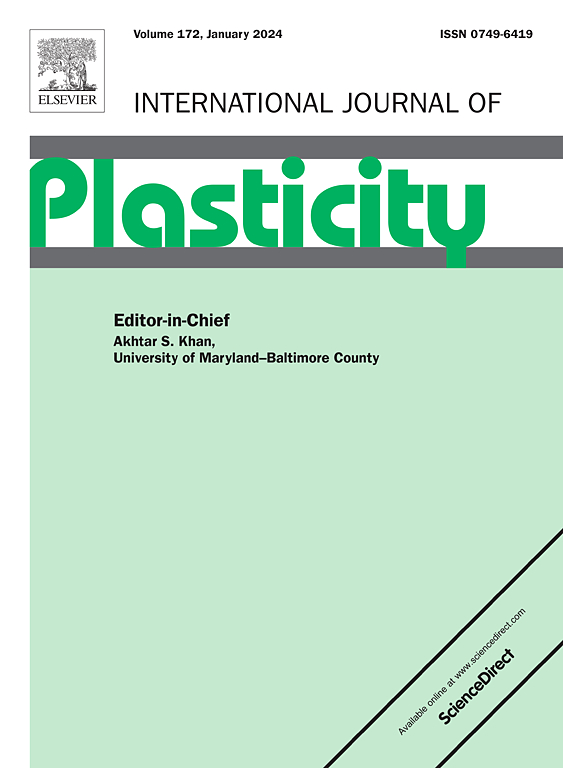层间轧制集成定向能沉积制造的中熵合金具有优异的抗疲劳性能
IF 12.8
1区 材料科学
Q1 ENGINEERING, MECHANICAL
引用次数: 0
摘要
定向能沉积(DED)具有较高的制造效率和材料利用率,适合生产大型结构部件。然而,由于柱状粗大晶粒和制造缺陷的存在,如何显著提高ded制造的面心立方(FCC)材料的抗疲劳性能是一个重要而又具有技术挑战性的问题。为了解决这一挑战,本研究采用了一种中熵FCC合金(CoCrNi)94Al3Ti3作为基材,并采用了一种将层间轧制集成到DED中的加工策略,以可控地引入层状结构,这是一种有效的抗疲劳组织。通过工艺优化,经3次层间轧制的样品(d - r3)的抗疲劳性能和沿轧制方向的疲劳比(RD)显著提高,分别比DED样品高60%和48%。层间轧制引入的层状异质组织由粗晶和细晶交替组成,粗晶占66.7%,细晶占33.3%。这种层状异质结构是由冷轧引起的高几何必需位错密度和循环加热的临界再结晶温度造成的,促进了局部位置的柱状向等轴转变。d - r3样品的高抗疲劳性能是由于同时实现了循环稳定性和抗片层异质结构的裂纹扩展。一方面,通过准原位疲劳实验揭示了强化的裂纹起裂机制:与DED试样中强塑性应变局部化诱发晶界(GB)或滑移带(SB)裂纹不同,DED- r3试样中大多数裂纹是由SBs与缺陷相互作用引发的。层状组织对表面粗化的缓解抑制了微观组织开裂的风险。另一方面,由异质结构界面引起的宏观挠度和致密GBs引起的高频挠度共同降低了裂纹扩展速率。本文章由计算机程序翻译,如有差异,请以英文原文为准。
Lamellar microstructure enables exceptional fatigue resistance in a medium-entropy alloy manufactured by integrated directed energy deposition with interlayer rolling
Directed energy deposition (DED) offers higher manufacturing efficiency and material utilization, making it suitable for producing large-sized structural components. However, due to columnar coarse grains and manufactured defects, how to remarkably elevate the fatigue resistance of DED-fabricated face-centered cubic (FCC) materials is an important yet technically challenging issue. To address the challenge, this study employed a medium-entropy FCC alloy, (CoCrNi)94Al3Ti3, as the base material and adopted a processing strategy that integrates interlayer rolling into DED to controllably introduce lamellar structure, an effective fatigue-resistant microstructure. Through process optimization, the sample with 3-time inter-layer rolling (DED-R3) exhibits a significantly enhanced fatigue resistance and fatigue ratio along the rolling direction (RD), higher than DED sample by 60 % and 48 %, respectively. The lamellar heterostructure introduced by inter-layer rolling consists of alternating coarse and fine grains, with coarse grains accounting for 66.7 % and fine grains for 33.3 %. This lamellar heterostructure resulted from high geometrically necessary dislocation density induced by cold rolling and critical recrystallization temperature through cyclic heating, facilitating columnar-to-equiaxed transition at local positions. The high fatigue resistance of DED-R3 samples was attributed to the simultaneous achievement of cyclic stability and resistance to crack propagation from lamellar heterostructure. On the one hand, quasi-in-situ fatigue experiments were conducted to reveal enhanced crack initiation mechanisms: different from intense plastic strain localization induced grain boundary (GB) or slip band (SB) cracks in DED samples, most cracks in DED-R3 samples initiated from the interaction between SBs and defects. The mitigated surface roughening by lamellar microstructure suppressed the risk of microstructure cracking. On the other hand, the macroscopic deflection induced by the heterostructure interface and the high-frequency deflection by dense GBs collectively reduced the crack propagation rate.
求助全文
通过发布文献求助,成功后即可免费获取论文全文。
去求助
来源期刊

International Journal of Plasticity
工程技术-材料科学:综合
CiteScore
15.30
自引率
26.50%
发文量
256
审稿时长
46 days
期刊介绍:
International Journal of Plasticity aims to present original research encompassing all facets of plastic deformation, damage, and fracture behavior in both isotropic and anisotropic solids. This includes exploring the thermodynamics of plasticity and fracture, continuum theory, and macroscopic as well as microscopic phenomena.
Topics of interest span the plastic behavior of single crystals and polycrystalline metals, ceramics, rocks, soils, composites, nanocrystalline and microelectronics materials, shape memory alloys, ferroelectric ceramics, thin films, and polymers. Additionally, the journal covers plasticity aspects of failure and fracture mechanics. Contributions involving significant experimental, numerical, or theoretical advancements that enhance the understanding of the plastic behavior of solids are particularly valued. Papers addressing the modeling of finite nonlinear elastic deformation, bearing similarities to the modeling of plastic deformation, are also welcomed.
 求助内容:
求助内容: 应助结果提醒方式:
应助结果提醒方式:


